
We frequently look for new and healthy ways to eat. Finding a way to enhance fresh fruit, without adding sugar, seemed like a worthy challenge.
We found a simple, easy way by adding one additional ingredient.
We selected a mix of fresh berries and made it even more delicious, with the addition of toasted unsweetened coconut.
Stovetop toasting is remarkably quick and easy, and it has the added benefit of leaving your kitchen smelling great. It only takes a few minutes and is well worth the effort.
Berries with Toasted Coconut
Ingredients
- 1 cup berries mixed
- 1/4 cup unsweetened coconut flakes lightly toasted
Instructions
- Select your choice of fresh berries. Rinse, dry and place in serving container.
- Warm a pan on medium heat and measure coconut flakes into pan. Lightly stir until flakes begin to brown and you smell warm coconut.
- Sprinkle toasted coconut onto berries. Enjoy!




 Northwest of Bend, a man-made lake occupies a space made up of igneous rock, once cut into by three rivers. This is where the Metolius and Crooked join the Deschutes river. The waters of Billy Chinook draw hundreds of power boaters from May to November, however in the winter months, the canyon walls are quieter and we can indulge our geological interests in relative peace.
Northwest of Bend, a man-made lake occupies a space made up of igneous rock, once cut into by three rivers. This is where the Metolius and Crooked join the Deschutes river. The waters of Billy Chinook draw hundreds of power boaters from May to November, however in the winter months, the canyon walls are quieter and we can indulge our geological interests in relative peace.




 With an outlook for sun and no snow storms, we headed northeast to take a couple of days and do some birding along the Columbia River flyway. There have been a lot of day trips to nearby hiking sites, but a bit of cabin fever and the prospect of seeing a wide variety of migratory birds drew us to Boardman and the Umatilla National Wildlife Refuge. Fifteen hundred of the 23 thousand acre reserve is irrigated crop lands providing cover and food for the waterfowl and raptors.
With an outlook for sun and no snow storms, we headed northeast to take a couple of days and do some birding along the Columbia River flyway. There have been a lot of day trips to nearby hiking sites, but a bit of cabin fever and the prospect of seeing a wide variety of migratory birds drew us to Boardman and the Umatilla National Wildlife Refuge. Fifteen hundred of the 23 thousand acre reserve is irrigated crop lands providing cover and food for the waterfowl and raptors. Highway 97, north of Grass Valley and almost to Biggs, was covered in freezing fog that left a beautiful covering of rime frost on everything. The ODOT trucks had been through with de-icer so roads were drivable and we enjoyed the photo ops the eerie scenery offered.
Highway 97, north of Grass Valley and almost to Biggs, was covered in freezing fog that left a beautiful covering of rime frost on everything. The ODOT trucks had been through with de-icer so roads were drivable and we enjoyed the photo ops the eerie scenery offered.













